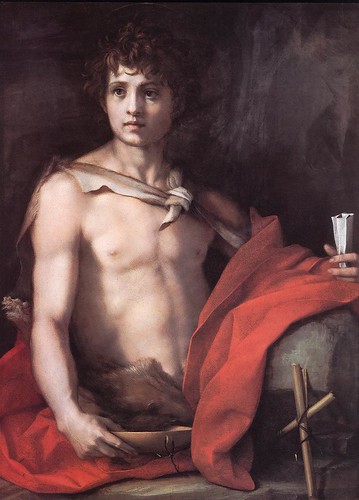Amongst these treasures, I settled first on the great Raphael (Raffaello Sanzio)), which Madonna del Granduca had always been one of my all time favorite paintings. This painting was painted in 1505, shortly after Rapheal arrived in Florence. It belonged to the Grand Duke of Tuscany Ferdinand III, therefore the painting gained its name.

Madonna del Granduca, 1505, Raphael, source: wikipedia
United States public domain tag
This close-up Madonna painting has the closeness and intimacy many other grander versions lacked. The Virgin was melancholic and passive, the Child clinging to his mother, gazed upon the viewers with knowledge. The warm skin tones, with light glowing underneath, contrasted strongly against the dark background and the rich colors of the dress and robe of Mary's - the blueish green and scarlet red were so saturated that after half a century, they still glowed with life within and it seemed that I could still feel the wetness and sense the pungent smell of the pigments.
My second favorite work was more a personal choice - there were many greater artists' greater works, but to me, Andrea del Sarto's half-length John the Baptist was as memorable and beautiful as Michelangelo's David - the same vitality, innocence, beauty, and sense of duty.
This portrait, done in a very realistic style, almost, but shy of the dramatic effect of Caravaggio. However, I did prefer this more subdued approach to highly dramatic gestures. To me, the sad fate of John the Baptist, did not call for any such emphasis. The drama had been built into his name, his life and his imagery. Andrea del Sarto, like Michelangelo, chose to portrait the protagonist at his more private moment, quiet, before the storm. St John here was a beautiful lad, with pelt wrapped around his waist, a startling splash of red robe embraced him as if foretelling the blood he was to shed. His large and intelligent looking eyes gazed over the viewers into the distance, steady, and unafraid. This perhaps was just an excuse for Andrea del Sarto to paint a half-nude body, as many religious paintings since Renaissance time, but the power of divine and chastity was emphasized through his physical beauty, particularly for the viewers familiar with his death in the New Testament version.

John the Baptist, 1528, Andrea del Sarto
Even when one had to concede that this painting concentrated too much on the surface beauty, one cannot deny the marvel of the beauty and the sense of wonder of the painting. It was a masterpiece, however deemed minor. Incidentally, Andrea del Sarto was considered less than truly great. Artist and art historian, Vasari, trained by Andrea del Sarto, "was highly critical of his teacher, alleging that, though having all the prerequisites of a great artist, he lacked ambition and that divine fire of inspiration which animated the works of his more famous contemporaries, like Leonardo, Michelangelo, and Raphael." [wikipedia]
My Favorite Museum Collection Series
>> My Favorite Museum Collection Series 18: My Favorite Sculptures at Museo Nazionale del Bargello, Firenze, Italia
<< My Favorite Museum Collection Series 16: My Favorite Paintings at Galleria degli Uffizi, Firenze





No comments:
Post a Comment